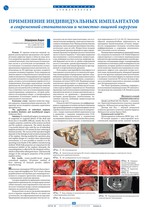Применение индивидуальных имплантатов в современной стоматологии и челюстно-лицевой хирургии


стр. 64-65
Аннотация
В черепно-челюстно-лицевой хирургии реконструкция врожденных или приобретенных дефектов черепа и области лица является невероятно трудной, главным образом, из-за сложной анатомии, чувствительности вовлеченных систем и эстетической составляющей. Статья описывает 3 успешных клинических случая с применением индивидуальных имплантатов, напечатанных на 3D-принтере методом лазерного спекания титанового порошка. Успех операции во многом зависит от биологических и механических свойств имплантата. Смоделировав план операции и дизайн имплантата в современной трехмерной среде, сегодня стало возможным перенести его в операционную благодаря аддитивному способу производства. В то время как объемные свойства важны для механической устойчивости имплантата, в конечном счете на остеоинтеграцию влияет спроектированная поверхность, которой добиваются последующим микро- и наноразмерным изменением остеогенных свойств поверхности напечатанного имплантата.
Аннотация (англ)
In craniofacial surgery, reconstruction of congenital or acquired defects of the skull and facial area is incredibly difficult, mainly due to the complex anatomy, sensitivity of the systems involved and the aesthetic component. The article describes 3 successful clinical cases with the use of individual implants printed on a 3D-printer by laser sintering of titanium powder. The success of the operation largely depends on the biological and mechanical properties of the implant. Having modeled the operation plan and implant design in a modern three-dimensional environment, it is now possible to transfer it to the operating room thanks to the additive manufacturing method. While bulk properties are important for the mechanical stability of the implant, ultimately, the osseointegration is affected by the designed surface, which is achieved by subsequent micro- and nanoscale changes in the osteogenic properties of the printed implant surface.
Ключевые Слова
черепно-челюстно-лицевая хирургия, индивидуальные имплантаты, 3D-принтер, метод лазерного спекания, аддитивное производство.
Ключевые Слова (англ)
cranio-maxillo-facial surgery, customized implants, 3D-printer, method of laser sintering of titanium powder, additive manufacturing.
Список литературы
1. Журнал Черепно-лицевая хирургия 2016;27: 2113-2116.
2. Cochran, D.L. A comparison of endosseous dental implant surfaces. J. Periodontol. 70, 1523-1539 (1999).
3. Cochran, D.L. et al. The use of reduced healing times on iti implants with a sandblasted and acid-etched (sla) surface: Early results from clinical trials on iti sla implants. Clin. Oral. Implants. Res. 13, 144-153 (2002).
4. Derand, P., Hirsch, J.M. Virtual bending of mandibular reconstruction plates using a computer-aided design. J. Oral Maxillofac Surg 2009;67:1640-1643.
5. Gittens, R.A. et al. Differential responses of osteoblast lineage cells to nanotopographically-modified, microroughened titanium-aluminum-vanadium alloy surfaces. Biomaterials. 33, 8986-8994 (2012).
6. Gittens, R.A., Olivares-Navarrete, R., Schwartz, Z. & Boyan, B.D. Implant osseointegration and the role of microroughness and nanostructures: Lessons for spine implants. Acta Biomater. 10, 3363-3371 (2014).
7. Gittens, R.A. et al. Superposition of nanostructures on microrough titanium-aluminum-vanadium alloy surfaces results in an altered integrin expression profile in osteoblasts. Connect. Tissue Res. 55, 164-168 (2014).
8. Gittens, R.A. et al. The roles of titanium surface micro/nanotopography and wettability on the differential response of human osteoblast lineage cells. Acta Biomater. 9, 6268-6277 (2013).
9. Leiggener, C., Messo, E., Thor, A., et al. A selective laser sintering guide for transferring a virtual plan to real time surgery in composite mandibular reconstruction with free fibula osseous flaps. Int J. Oral Maxillofac Surg 2009;38:187-192.
10. Lincks, J. et al. Response of mg63 osteoblast-like cells to titanium and titanium alloy is dependent on surface roughness and composition. Biomaterials. 19, 2219-2232 (1998).
11. Novel osteogenic Ti-6Al-4V device for restoration of dental function in patients with large bone deficiencies: design, development and implementation, D.J.Cohen, A.Cheng, A.Kahn, M.A viram, A.J.Whitehead, S.L.Hyzy, R.M.Clohessy, B.D.Boyan & Z.Schwartz - Published: Scientific Reports, 08 February 2016.
12. Schwartz, Z. et al. Effect of micrometer-scale roughness of the surface of ti6al4v pedicle screws in vitro and in vivo. J. Bone Joint Surg. Am. 90, 2485-2498 (2008).
13. Wang, X. et al. Effects of structural properties of electrospun tio2 nanofiber meshes on their osteogenic potential. Acta Biomater. 8, 878-885 (2012).
2. Cochran, D.L. A comparison of endosseous dental implant surfaces. J. Periodontol. 70, 1523-1539 (1999).
3. Cochran, D.L. et al. The use of reduced healing times on iti implants with a sandblasted and acid-etched (sla) surface: Early results from clinical trials on iti sla implants. Clin. Oral. Implants. Res. 13, 144-153 (2002).
4. Derand, P., Hirsch, J.M. Virtual bending of mandibular reconstruction plates using a computer-aided design. J. Oral Maxillofac Surg 2009;67:1640-1643.
5. Gittens, R.A. et al. Differential responses of osteoblast lineage cells to nanotopographically-modified, microroughened titanium-aluminum-vanadium alloy surfaces. Biomaterials. 33, 8986-8994 (2012).
6. Gittens, R.A., Olivares-Navarrete, R., Schwartz, Z. & Boyan, B.D. Implant osseointegration and the role of microroughness and nanostructures: Lessons for spine implants. Acta Biomater. 10, 3363-3371 (2014).
7. Gittens, R.A. et al. Superposition of nanostructures on microrough titanium-aluminum-vanadium alloy surfaces results in an altered integrin expression profile in osteoblasts. Connect. Tissue Res. 55, 164-168 (2014).
8. Gittens, R.A. et al. The roles of titanium surface micro/nanotopography and wettability on the differential response of human osteoblast lineage cells. Acta Biomater. 9, 6268-6277 (2013).
9. Leiggener, C., Messo, E., Thor, A., et al. A selective laser sintering guide for transferring a virtual plan to real time surgery in composite mandibular reconstruction with free fibula osseous flaps. Int J. Oral Maxillofac Surg 2009;38:187-192.
10. Lincks, J. et al. Response of mg63 osteoblast-like cells to titanium and titanium alloy is dependent on surface roughness and composition. Biomaterials. 19, 2219-2232 (1998).
11. Novel osteogenic Ti-6Al-4V device for restoration of dental function in patients with large bone deficiencies: design, development and implementation, D.J.Cohen, A.Cheng, A.Kahn, M.A viram, A.J.Whitehead, S.L.Hyzy, R.M.Clohessy, B.D.Boyan & Z.Schwartz - Published: Scientific Reports, 08 February 2016.
12. Schwartz, Z. et al. Effect of micrometer-scale roughness of the surface of ti6al4v pedicle screws in vitro and in vivo. J. Bone Joint Surg. Am. 90, 2485-2498 (2008).
13. Wang, X. et al. Effects of structural properties of electrospun tio2 nanofiber meshes on their osteogenic potential. Acta Biomater. 8, 878-885 (2012).
Другие статьи из раздела «Клиническая стоматология»
- Комментарии
Загрузка комментариев...
|
Поделиться:
|

 PDF)
PDF)


